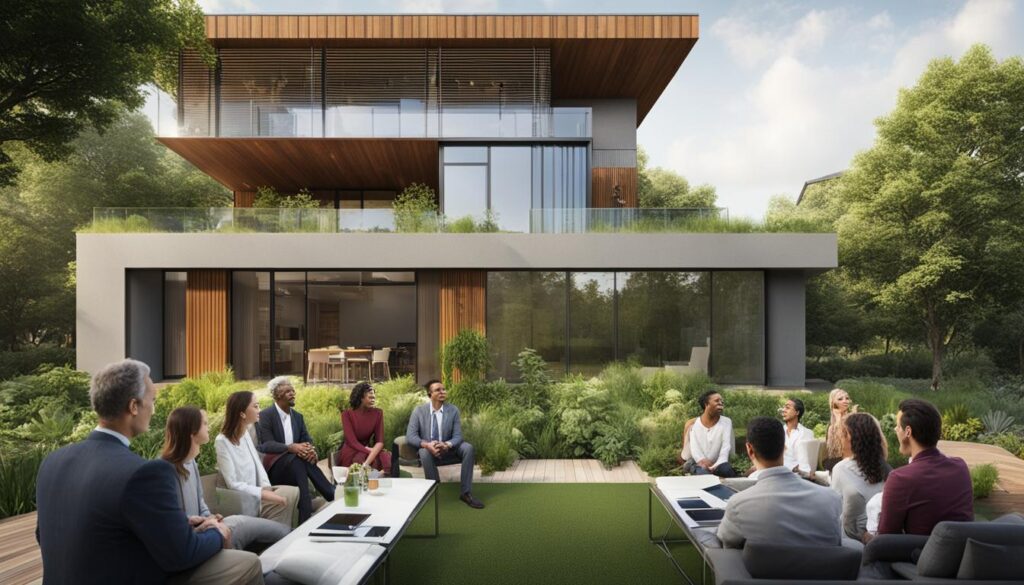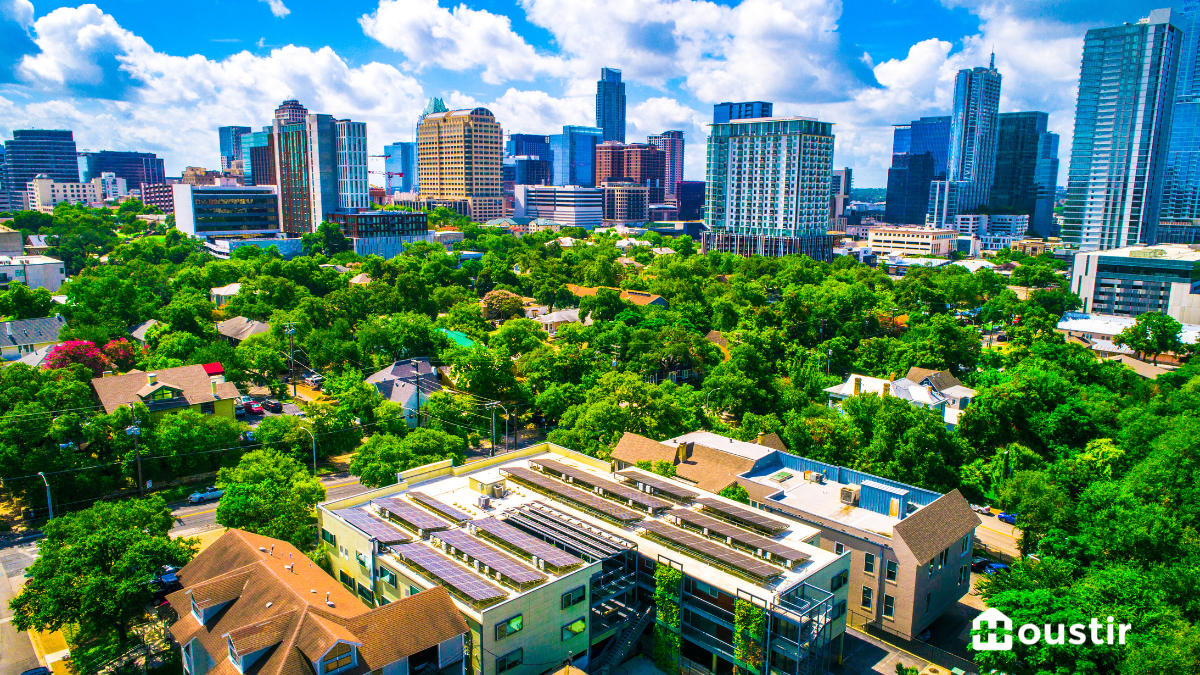Real estate brokerage plays a crucial role in shaping sustainable property development and navigating the complex real estate market. It involves designing, building, and managing real estate projects with the aim of minimizing environmental impact and maximizing social and economic benefits. Sustainable real estate development can contribute to the achievement of sustainable development goals by reducing greenhouse gas emissions, conserving energy and water resources, and promoting the use of renewable energy sources. Real estate brokerages like Houstir Inc. are actively involved in promoting sustainability in the industry through their services and initiatives.

Key Takeaways:
- Real estate brokerage plays a vital role in sustainable property development.
- Sustainable real estate development aims to minimize environmental impact while maximizing social and economic benefits.
- Houstir Inc. is an example of a real estate brokerage actively promoting sustainability.
- Sustainable real estate development helps achieve sustainable development goals by reducing emissions and conserving resources.
- Real estate brokerages contribute to a more sustainable and resilient future.
Defining Sustainable Real Estate Development
Sustainable real estate development is a progressive approach to designing, building, and managing property projects that prioritize environmental stewardship and social responsibility. It goes beyond the traditional focus on profitability to consider the long-term impact on the planet and its inhabitants. By integrating sustainable practices into real estate projects, developers can minimize the negative environmental impact while maximizing the social and economic benefits.
At its core, sustainable real estate development seeks to strike a harmonious balance between meeting the needs of the present generation and preserving resources for future generations. It encompasses a wide range of strategies aimed at reducing carbon emissions, conserving energy and water, promoting biodiversity, and creating healthier and more livable communities.
Key Elements of Sustainable Real Estate Development
1. Energy Efficiency: Implementing energy-efficient design and technologies, such as smart lighting systems, insulation, and renewable energy sources, to reduce energy consumption and greenhouse gas emissions.
2. Water Conservation: Incorporating water-efficient fixtures, rainwater harvesting systems, and greywater recycling to minimize water usage and contribute to water resource preservation.
3. Materials Selection: Choosing eco-friendly materials, such as recycled or locally sourced materials, low VOC paints, and sustainably harvested wood, to reduce the environmental impact of construction and improve indoor air quality.
4. Site Design: Designing green spaces, integrating green infrastructure like permeable pavements, and preserving natural habitats to enhance biodiversity, mitigate heat island effect, and promote overall sustainability.
Achieving sustainable real estate development requires a holistic approach that considers the entire lifecycle of a property project, from planning and design to construction, operation, and eventual decommissioning. It also involves collaboration between developers, architects, contractors, and other stakeholders to ensure sustainable practices are implemented at every stage.
The Benefits of Sustainable Real Estate Development
Sustainable real estate development provides numerous benefits on multiple fronts:
| Environmental Impact | Social Benefits | Economic Advantages |
|---|---|---|
| – Reduces carbon emissions | – Creates healthier communities | – Attracts environmentally conscious customers and investors |
| – Conserves natural resources | – Enhances quality of life | – Lowers operating costs through energy and water efficiency |
| – Protects biodiversity | – Provides access to green spaces | – Increases property value |
| – Minimizes environmental footprint | – Promotes social equity | – Supports local economies |
Realizing the Potential of Sustainable Real Estate Development
To embrace sustainable real estate development, developers need to adopt innovative and forward-thinking practices, leverage technology to optimize resource usage, and prioritize social and environmental responsibility. By doing so, they can contribute to a more sustainable and resilient future, create positive social impact, and enjoy long-term economic benefits.
“Sustainable development is the pathway to the future we want for all. It offers a framework to generate economic growth, achieve social justice, exercise environmental stewardship, and strengthen governance.” – Ban Ki-moon
By defining sustainable real estate development and recognizing its benefits, real estate professionals and stakeholders can be catalysts for positive change, driving the adoption of sustainable practices across the industry. Together, we can shape a future where sustainable development is the norm, not the exception.
Energy Efficiency in Sustainable Real Estate Development
When it comes to sustainable real estate development, energy efficiency plays a critical role in reducing greenhouse gas emissions and minimizing operating costs. By incorporating energy-efficient practices into the design and systems of buildings, developers can create environmentally responsible properties that benefit both the planet and their bottom line.
To enhance energy efficiency, developers should prioritize the use of energy-efficient appliances, lighting, heating, ventilation, and air conditioning (HVAC) systems. These technologies not only consume less energy but also contribute to the reduction of greenhouse gas emissions, promoting a cleaner and healthier environment.
Implementing high-performance windows in buildings is another effective strategy to enhance energy efficiency. These windows are designed to minimize heat transfer, keeping the interior comfortable while reducing the need for excessive heating or cooling. Additionally, they can provide better natural lighting, reducing the reliance on artificial lighting and further conserving energy.
Renewable energy sources such as solar panels are also vital in sustainable real estate development. By harnessing the power of the sun, developers can generate clean and renewable energy to power their buildings, significantly reducing reliance on fossil fuels and further lowering greenhouse gas emissions.
The Benefits of Energy Efficiency in Sustainable Real Estate Development
The integration of energy-efficient practices in sustainable real estate development offers several benefits:
- Reduced greenhouse gas emissions: Energy-efficient buildings consume less energy, resulting in reduced greenhouse gas emissions and a smaller carbon footprint.
- Lower operating costs: By using less energy, property owners can enjoy significant cost savings on their energy bills, minimizing long-term operating costs.
- Enhanced marketability: Energy-efficient buildings are increasingly sought after by environmentally conscious tenants and buyers, enhancing the marketability and value of the property.
- Improved indoor comfort: Energy-efficient designs not only reduce energy consumption but also contribute to improved thermal comfort and better indoor air quality for occupants.
Investing in energy efficiency is a win-win situation for developers, occupants, and the environment. Not only does it contribute to the sustainable development goals of reducing greenhouse gas emissions and conserving energy resources, but it also provides long-term financial savings and a healthier living or working environment for occupants.
With the aim of promoting energy efficiency in sustainable real estate development, Houstir Inc., a leading real estate brokerage, provides expert guidance and support to developers looking to create energy-efficient properties that align with sustainability goals. Contact Houstir Inc. today at 805-947-6370 or email [email protected] to learn more about their sustainable real estate development services or visit their website at https://joinhoustir.com/.
Join Houstir for 100% commission real estate in California
Our managing brokers and agent success team are eager to assist you throughout the entire process.

Water Conservation in Sustainable Real Estate Development
Water conservation is a crucial component of sustainable real estate development. By implementing water-efficient design strategies, developers can significantly reduce water usage, protect local resources, and lower operating costs.
One effective approach is the use of low-flow toilets and faucets, which optimize water usage without compromising functionality. These fixtures are designed to deliver the same performance while consuming less water, contributing to overall water conservation efforts.
In addition, greywater recycling systems are a sustainable solution that can be integrated into real estate projects. Greywater refers to wastewater from sources such as sinks, showers, and laundry machines, which can be treated and reused for non-potable purposes like irrigation and flushing toilets. Implementing greywater recycling systems helps reduce water demand and minimizes the strain on local water resources.
Another water conservation technique is xeriscaping, a landscaping approach that minimizes the need for irrigation. By utilizing drought-tolerant plants, mulch, and efficient irrigation systems, developers can create visually appealing outdoor spaces while minimizing water usage.
These water conservation strategies not only contribute to the overall sustainability of real estate projects but also reduce the impact on the environment. By conserving water resources, developers can play a vital role in ensuring the long-term availability of this precious resource.
Materials Selection in Sustainable Real Estate Development
In sustainable real estate development, the selection of materials plays a crucial role in reducing the environmental impact of projects. By consciously choosing sustainable building materials, developers can contribute to a greener and more sustainable future.
One effective approach to materials selection is the use of recycled materials. Incorporating recycled metals, plastics, and wood not only reduces the demand for raw materials but also minimizes the environmental impacts associated with their extraction and processing.
Local sourcing of construction materials is another key strategy. By obtaining materials from nearby suppliers, developers can significantly cut transportation emissions, promoting sustainability while supporting the local economy.
Furthermore, the integration of sustainable building materials creates a healthier indoor environment for occupants. For instance, using low-VOC (volatile organic compounds) paints and finishes reduces harmful emissions and enhances indoor air quality.
Benefits of Materials Selection in Sustainable Real Estate Development
“By consciously choosing sustainable building materials, developers can contribute to a greener and more sustainable future.”
The benefits of sustainable materials selection extend beyond the environmental impact. Here are key advantages:
- Reduced environmental footprint: Sustainable building materials help reduce greenhouse gas emissions, minimize waste generation, and conserve natural resources.
- Improved occupant health: Low-VOC materials promote better indoor air quality and minimize health risks for occupants.
- Enhanced market value: Sustainable real estate projects have a competitive edge in the market, as conscious consumers increasingly prioritize environmentally friendly properties.
- Compliance with regulations: Incorporating sustainable materials aligns projects with relevant environmental regulations and certifications.
Houstir Inc.’s Commitment to Sustainable Materials
“Houstir Inc. is committed to promoting sustainable materials selection in real estate development.”
Houstir Inc., a leading real estate brokerage, recognizes the importance of sustainable materials selection. They consistently advise clients on using eco-friendly materials and collaborate with suppliers specializing in sustainable building products.
Sustainable Materials Showcase – Recycled Materials
Explore the sustainable potential of recycled building materials:
| Material | Advantages |
|---|---|
| Recycled Metal | Durable, reduces the demand for new metal extraction |
| Recycled Plastic | Lightweight, versatile, reduces plastic waste |
| Recycled Wood | Renewable, reduces deforestation, saves energy in production |
By including recycled materials in real estate projects, developers actively contribute to waste reduction efforts and foster a more sustainable construction industry.

Site Design in Sustainable Real Estate Development
When it comes to sustainable real estate development, site design plays a crucial role in minimizing the environmental impact of a project. By carefully considering the sustainability of the site design, developers can create developments that benefit both the environment and the surrounding community.
One important aspect of sustainable site design is the preservation of natural habitats and biodiversity. By designing around existing natural features, developers can minimize disruption to ecosystems and protect valuable wildlife habitats. This not only contributes to the conservation of biodiversity but also enhances the overall ecological value of the project.
Creating green spaces within the development is another key element of sustainable site design. These green spaces provide numerous benefits, including improved air quality, reduced urban heat island effect, and opportunities for recreation and relaxation. They also contribute to the overall well-being of the community and create a sense of place.
Site design also plays a role in rainwater management, which is crucial for minimizing the risk of flooding and erosion in the local area. By incorporating elements such as permeable pavements, rain gardens, and bioswales, developers can effectively manage stormwater runoff and promote groundwater recharge, reducing the burden on the municipal stormwater system.
Furthermore, sustainable site design prioritizes efficient land use and transportation choices. By promoting walkability, bikeability, and access to public transit, developers can reduce the reliance on private vehicles and encourage sustainable modes of transportation. This not only improves the overall accessibility of the development but also reduces traffic congestion and associated greenhouse gas emissions.
To achieve sustainable site design, developers can work with professionals who specialize in sustainable landscape architecture and urban planning. These experts can provide guidance on best practices and help integrate sustainable design principles into the development process.
In the case of Houstir Inc., a real estate brokerage committed to sustainable development, site design is a fundamental consideration in all their projects. They collaborate with experienced architects and landscape designers to ensure that every development minimizes its environmental impact and maximizes its benefits to the community.
If you’re interested in sustainable real estate development, Houstir Inc. is dedicated to helping you achieve your goals. Contact them at 805-947-6370 or email [email protected]. To learn more about their services, visit their website here.
Want the experience of the best 100% commission model? reach out to us.
Our managing brokers and agent success team are eager to assist you throughout the entire process.

Benefits of Sustainable Real Estate Development
Sustainable real estate development offers numerous benefits both to the environment and to stakeholders. Environmentally, it helps reduce greenhouse gas emissions, conserve water resources, protect natural habitats, and promote biodiversity.
Economically, sustainable development leads to lower operating costs through energy and water efficiency, attracting environmentally conscious customers and investors, and enhancing the value of the property.
Socially, sustainable development creates healthier and more livable communities, provides access to green spaces, and improves the overall quality of life.
| Environmental Benefits | Economic Benefits | Social Benefits |
|---|---|---|
| Reduces greenhouse gas emissions | Lowers operating costs | Creates healthier communities |
| Conserves water resources | Attracts environmentally conscious customers and investors | Provides access to green spaces |
| Protects natural habitats | Enhances property value | Improves quality of life |
| Promotes biodiversity |
These benefits make sustainable real estate development a compelling choice for developers and investors alike. By incorporating sustainable practices, such as energy efficiency, water conservation, materials selection, and site design, we can build a more environmentally friendly and socially responsible future.
At Houstir Inc., we are committed to sustainable real estate development and offer a range of services to help you achieve your sustainable development goals. Contact us today to learn more about our services and how we can support your sustainable real estate projects.
Contact Information:
Name: Houstir Inc.
Phone Number: 805-947-6370
Email Address: [email protected]
Examples of Sustainable Real Estate Developments
There are several notable examples of sustainable real estate developments around the world. These projects serve as inspiring models for creating environmentally friendly and energy-efficient buildings. Let’s take a closer look at some of these global projects:
The Bullitt Center, Seattle, USA
The Bullitt Center, located in Seattle, USA, is a pioneering green office building. It showcases innovative sustainability features such as rainwater-catching systems and rooftop solar panels. By capturing rainwater for reuse and generating clean energy through solar power, this development significantly reduces its environmental impact while providing a functional and productive workspace.
The Museum of Tomorrow, Rio de Janeiro, Brazil
In Rio de Janeiro, Brazil, the Museum of Tomorrow stands as a prime example of sustainable real estate development. This iconic structure incorporates rooftop solar panels and rainwater catchers to reduce its energy consumption. By harnessing renewable energy sources and utilizing rainwater, the museum demonstrates how sustainable practices can be seamlessly integrated into architectural design.
The Eden Project, Cornwall, England
The Eden Project in Cornwall, England, consists of massive greenhouses that house a wide array of plant species. This unique development incorporates sustainable building materials and renewable energy sources, demonstrating the harmonious coexistence of nature and modern architecture. By showcasing ecological beauty while prioritizing sustainability, the Eden Project sets a remarkable standard for sustainable real estate.
The Zero Carbon Building, Hong Kong
Hong Kong’s Zero Carbon Building showcases the possibilities of energy-efficient design and renewable energy systems. With its cutting-edge technologies and architectural strategies, this development achieves a significant reduction in energy consumption and carbon emissions. By prioritizing carbon neutrality, the Zero Carbon Building underscores the potential of sustainable real estate in combating climate change.
These examples highlight the immense opportunities and potential of sustainable real estate developments on a global scale. By incorporating innovative technologies, renewable energy sources, and environmentally conscious design principles, these projects not only contribute to a greener future but also inspire and influence the broader real estate industry.
The Importance of ESG Reporting in Real Estate
ESG (environmental, social, and governance) reporting is highly significant in the real estate industry. Many real estate companies, including Houstir Inc., integrate ESG information into their investor and public reporting. By doing so, they highlight key performance indicators such as energy usage, greenhouse gas emissions, waste management, and employee diversity. ESG reporting allows companies to track their progress, compare their performance with industry benchmarks, and showcase their commitment to sustainability and responsible social policies. Furthermore, investors are increasingly considering ESG factors when making investment decisions, as they believe that these factors can mitigate downside risk and contribute to long-term financial performance.
Benefits of ESG Reporting in Real Estate
The inclusion of ESG reporting in the real estate sector brings about several benefits:
- Transparency and Accountability: ESG reporting promotes transparency by providing stakeholders with comprehensive information about a company’s environmental and social impact. It also holds companies accountable for their sustainability practices.
- Risk Management: ESG reporting helps companies identify and manage potential risks associated with environmental, social, and governance factors, allowing them to implement measures to mitigate those risks.
- Competitive Advantage: Real estate companies that prioritize ESG reporting gain a competitive edge in the market. Investors and customers are increasingly attracted to sustainable and socially responsible businesses.
- Enhanced Reputation: Demonstrating a commitment to sustainability through ESG reporting enhances a company’s reputation, attracting investors, clients, and top talent.
“ESG reporting provides real estate companies with valuable insights into their sustainability performance and enables stakeholders to make informed decisions based on environmental and social criteria. By incorporating ESG factors into their business strategies, real estate companies can improve their financial performance while making a positive impact on the planet and society.”
As investors prioritize sustainable investing, the demand for ESG reporting in the real estate sector continues to grow. By embracing ESG reporting practices, real estate companies can align their operations with the principles of sustainability, meet stakeholder expectations, and contribute to a more sustainable future.
ESG Reporting in Real Estate – A Comparison of Key Performance Indicators
| Key Performance Indicator | Company A | Company B |
|---|---|---|
| Energy Usage (kWh/sq ft) | 25.6 | 32.8 |
| Greenhouse Gas Emissions (tons CO2e) | 235.2 | 187.6 |
| Waste Management (tons/year) | 12.4 | 8.9 |
| Employee Diversity (%) | 62 | 48 |
The table above compares ESG performance between Company A and Company B in the real estate industry. Company A demonstrates stronger performance in terms of energy usage, greenhouse gas emissions, waste management, and employee diversity, indicating a greater commitment to sustainability and responsible social policies.
Conclusion
Real estate brokerage, such as Houstir Inc., plays a crucial role in shaping sustainable property development. By incorporating energy-efficient design, water conservation practices, materials selection, and sustainable site design, real estate brokerages contribute to creating environmentally friendly and socially responsible projects.
Sustainable real estate development offers numerous benefits to the environment, economy, and society. It helps reduce greenhouse gas emissions, conserve natural resources, lower operating costs, and create healthier and more livable communities. With sustainability becoming a priority for developers and investors, the integration of these principles into real estate brokerage practices is imperative for a more sustainable and resilient future.
Additionally, ESG reporting in the real estate industry plays a significant role in tracking progress, benchmarking performance, and demonstrating a commitment to sustainability. Monitoring key performance indicators, such as energy usage, waste management, and employee diversity, allows companies like Houstir Inc. to showcase their dedication to responsible business practices.
To shape the future of real estate development, it is crucial for real estate brokerages to continue championing sustainable practices, adopting ESG reporting, and collaborating with stakeholders to drive positive change. By doing so, the industry can contribute to a more sustainable and prosperous future in which environmental impact is minimized, social well-being is prioritized, and economic benefits are maximized.



